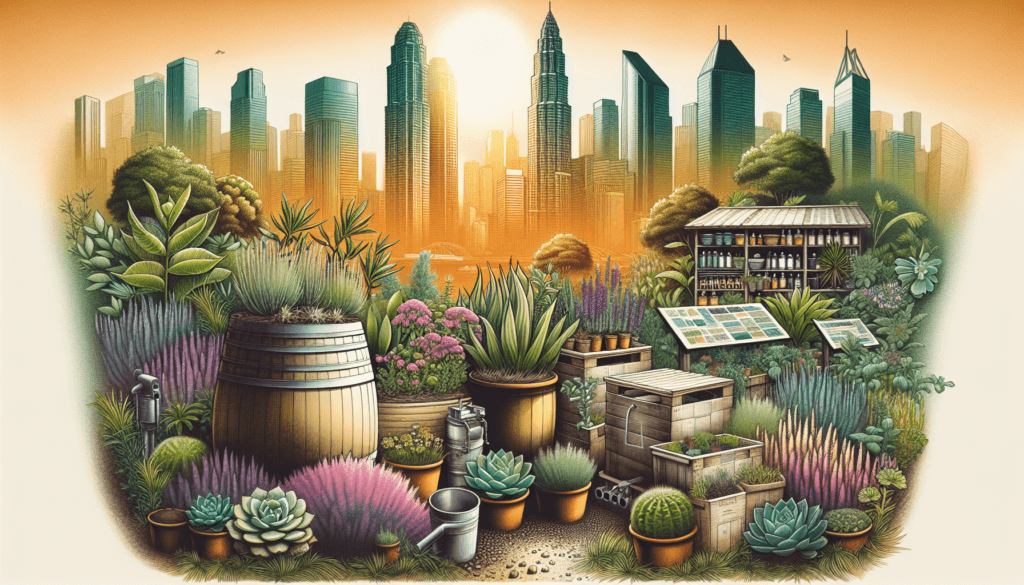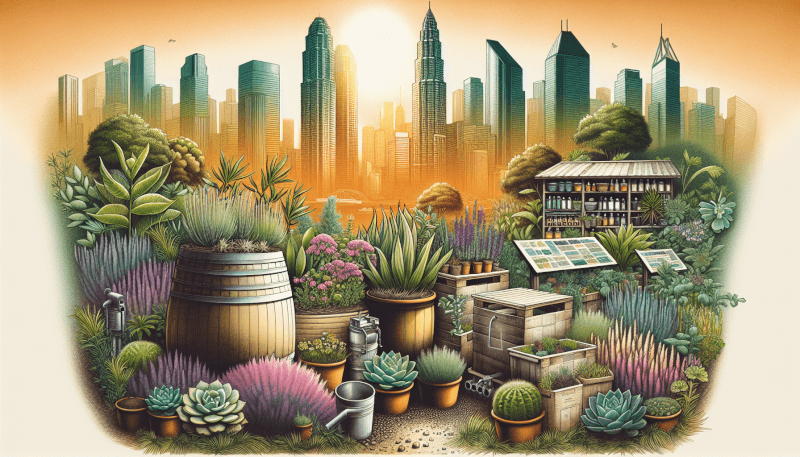Are you tired of seeing your garden suffer during dry spells? If so, then these urban gardening tips for creating a drought-resistant garden are just what you need. With water becoming an increasingly scarce resource, it’s more important than ever to find ways to conserve and make the most of what we have. In this article, we will explore a variety of techniques and strategies that will help you create a lush and thriving garden, even in the face of drought. From choosing the right plants to implementing efficient watering systems, we have got you covered. Get ready to transform your urban oasis into a haven of greenery and resilience.

Choosing the Right Plants
Drought-tolerant plant selection
When creating a drought-resistant garden, one of the first things to consider is choosing plants that are well-suited to dry conditions. Drought-tolerant plants have the ability to thrive with minimal water, making them ideal for regions that experience limited rainfall or where water conservation is a concern. Some popular drought-tolerant options include lavender, rosemary, succulents, and yucca. These plants have adapted to survive in arid environments by storing water in their leaves and stems or having deep root systems to access water deeper in the ground.
Native plants
Another excellent choice for a drought-resistant garden is to opt for native plants. Native plants are species that naturally occur in a particular area and have evolved to adapt to the local climate and soil conditions. Because they are already acclimated to the region, they often require less water and care than non-native species. Native plants also provide crucial habitat and food sources for local wildlife, promoting biodiversity in your garden.
Succulents and cacti
Succulents and cacti are well-known for their ability to survive in dry conditions. These plants have fleshy leaves or stems that store water, allowing them to withstand long periods without rainfall. Succulents, such as jade plants or aloe vera, make beautiful additions to any garden and require minimal watering. Cacti, like the prickly pear or barrel cactus, are also excellent choices for a drought-resistant garden due to their water-storing abilities.
Low-water annuals
While many annual flowers require regular watering to thrive, there are some low-water options that will still provide beautiful blooms while saving water. Look for flowers like zinnias, marigolds, or cosmos, which are known for their ability to tolerate drought. Incorporating low-water annuals into your garden can add a splash of color without excessive water usage, making them a perfect choice for a water-efficient urban garden.
Watering Techniques
Smart irrigation
One of the key components of a drought-resistant garden is efficient and smart irrigation. Traditional sprinkler systems can often lead to water wastage due to overspray or evaporation. Smart irrigation systems, on the other hand, utilize weather data and moisture sensors to deliver the right amount of water to your plants when they need it most. These systems can adjust watering based on rainfall, humidity, and temperature, ensuring that your garden receives just the right amount of water to thrive.
Drip irrigation
Drip irrigation is another excellent watering technique for a water-conscious garden. This method involves laying out a series of tubes or pipes with small holes, which allow water to slowly drip directly to the base of each plant. By delivering water directly to the roots, drip irrigation minimizes water loss through evaporation and targets the areas where plants need it most. This approach not only saves water but also reduces weed growth and minimizes disease by keeping foliage dry.
Mulching
Mulching is a simple yet effective technique for conserving water in your garden. By adding a layer of organic mulch, such as wood chips or straw, around your plants, you can help retain moisture in the soil. Mulch acts as a protective barrier, reducing evaporation and keeping the soil cool, which is especially beneficial during hot and dry periods. It also helps suppress weed growth, reducing the competition for water and nutrients in your garden.
Watering schedule
Establishing a consistent watering schedule is crucial for a drought-resistant garden. By watering your plants at specific times and intervals, you can ensure they receive the necessary moisture without wasting water. It is generally recommended to water deeply but infrequently, allowing the roots to access water from deeper layers of the soil. This promotes healthy root growth and makes your plants more resilient to drought. Avoid watering during the hottest part of the day when evaporation rates are highest, and consider installing a timer or using smartphone apps to help you maintain a regular watering schedule.

Soil Preparation
Improving soil quality
Before planting in your garden, it is essential to prepare the soil to create the optimal conditions for plant growth. Improving soil quality involves several steps, such as loosening compacted soil, removing weeds or rocks, and incorporating organic matter. Proper soil preparation allows for better water absorption and drainage, ensuring that your plants receive adequate moisture without becoming waterlogged.
Adding organic matter
One of the best ways to enhance soil quality is by adding organic matter. Organic matter, such as compost or well-rotted manure, adds nutrients to the soil and improves its structure. The addition of organic matter also increases the soil’s ability to retain water, reducing the need for frequent watering. It helps create a healthy environment for beneficial soil organisms, which can further improve the overall health and fertility of your garden.
Amending with compost
Compost is a gardener’s best friend when it comes to creating a drought-resistant garden. By adding compost to your soil, you can increase its water-holding capacity and promote better root growth. Compost also helps break up heavy clay soils, improving drainage, and prevents sandy soils from drying out too quickly. Additionally, the nutrients in compost provide a natural, slow-release fertilizer for your plants, reducing the need for additional synthetic fertilizers.
Retaining moisture
Retaining moisture in the soil is essential for a drought-resistant garden. To help your soil retain water, consider incorporating water-absorbing polymers or hydrogels into the soil. These products can absorb and store large amounts of water, releasing it gradually to the plants’ roots as needed. They are particularly useful for container gardens or areas with poor soil quality, where water retention can be a challenge.
Container Gardening
Choosing the right containers
Container gardening is a fantastic option for urban gardeners with limited space or those looking for more control over their garden’s water usage. When selecting containers for your plants, consider using materials that insulate against extreme temperature fluctuations, such as clay pots or plastic containers. These materials help protect plant roots from overheating or freezing, reducing stress and water requirements.
Proper drainage
Proper drainage is crucial for container gardening. Ensure that your containers have drainage holes at the bottom to prevent water from accumulating and causing root rot. Elevating containers on pot feet or using saucers to catch excess water can also help facilitate drainage and prevent waterlogging. By allowing excess water to escape, you can prevent water retention issues and keep your plants healthy.
Mulching
Mulching is just as important in container gardening as it is in traditional garden beds. Apply a layer of mulch, such as wood chips or gravel, on the soil surface of your containers. This helps to conserve moisture and prevent weed growth. Mulching provides an additional barrier against evaporation, keeping the soil consistently moist and reducing the frequency of watering.
Self-watering containers
To further optimize water usage in container gardening, consider using self-watering containers. These innovative planters have a water reservoir at the base that allows plants to draw water through capillary action. By reducing direct watering of the soil surface, self-watering containers help minimize evaporation and extend the time between watering. They are an excellent choice for busy gardeners or those who may be away from home for extended periods.

Vertical Gardening
Maximizing limited space
Vertical gardening is a fantastic way to make the most of limited space and create a lush, drought-resistant garden. By growing plants vertically, you can utilize walls, fences, or trellises, transforming empty spaces into green havens. Vertical gardens not only save space but also provide additional shading, reducing evaporation and keeping the surrounding area cooler.
Choosing appropriate structures
When embarking on vertical gardening, it is crucial to choose structures that can support the weight of your plants and withstand weather conditions. Sturdy trellises, wall-mounted planters, or modular vertical gardening systems are excellent options. Ensure that the materials used are durable, corrosion-resistant, and capable of holding soil and plants securely in place.
Selecting climbing plants
The success of a vertical garden relies heavily on choosing the right climbing plants. Opt for vines or creepers that are well-suited to your climate and require minimal water. Climbing plants with light-colored foliage can also help reflect sunlight and reduce heat absorption, further benefiting water conservation efforts in your garden. Popular choices for vertical gardening include ivy, jasmine, morning glory, and certain varieties of roses.
Watering techniques
When it comes to watering your vertical garden, consider using drip irrigation or micro-sprinklers. These methods ensure that water is delivered directly to the plants’ roots and minimize water loss through evaporation. Additionally, periodic hand watering or using a hose with a water wand attachment can help target specific areas that may need extra moisture. Regularly monitor the moisture levels in your vertical garden and make adjustments to your watering routine as necessary.
Rainwater Harvesting
Installing rain barrels
Rainwater harvesting is an excellent way to reduce reliance on municipal water supplies and make the most of natural resources. Installing rain barrels is a simple and effective method to collect and store rainwater for later use in your garden. Position the rain barrels near your downspouts, ensuring that they are securely fitted and properly sealed to prevent contamination. Collecting rainwater allows you to have a free and sustainable water source for your plants, especially during dry periods.
Utilizing rain chains
Rain chains are an aesthetically pleasing alternative to traditional downspouts and can be used to direct rainwater into containers or planting areas. These decorative chains create a cascade effect as the rainwater trickles down, making it not only functional but also visually appealing. Utilizing rain chains in your garden allows you to harvest rainwater while adding a unique and artistic element to your outdoor space.
Redirecting roof runoff
Redirecting roof runoff is another method of rainwater harvesting that can be used to benefit your garden. By installing gutters and downspouts, you can effectively collect rainwater as it flows off your roof. Direct the downspouts towards planting areas or containers, allowing the water to be evenly distributed. This simple technique maximizes the use of rainwater and ensures that it is effectively used to irrigate your garden.
Irrigating with collected rainwater
Once you have collected rainwater, there are various methods to use it for irrigation. In addition to hand watering, you can connect your rain barrels to a drip irrigation system or use a watering can to distribute the collected water. If using rainwater for irrigation, it is important to note that it may not meet the requirements for drinking water, so it should only be used on your garden and not for human consumption.

Shade and Sun Exposure
Using shade structures
In regions with intense sunlight or hot summers, providing shade for your plants is crucial to reduce water needs and prevent sun damage. Using shade structures, such as pergolas, shade sails, or umbrellas, can help protect your plants from excessive sun exposure. These structures not only provide relief from the heat but also reduce evaporation by creating a shaded microclimate in your garden.
Planting for sun exposure
Plant selection plays a significant role in managing sun exposure in your garden. By choosing plants that thrive in full sun or partial shade, you can ensure that they receive the appropriate amount of light without becoming stressed. Study the sun patterns in your garden, noting areas that receive direct sunlight and those that are partially shaded throughout the day. This will guide your plant selection and placement, allowing you to create the ideal conditions for each species.
Mulching to control temperature
Mulching not only helps retain soil moisture but can also assist in controlling temperature fluctuations. By applying a layer of organic mulch around your plants, you create an insulating barrier that reduces soil temperature and moisture loss due to evaporation. Mulching can keep the root zone cooler during hot summer months and warmer during colder seasons, providing your plants with a stable and favorable environment.
Creating microclimates
Creating microclimates within your garden can further optimize the sun exposure for specific plants. Microclimates are small areas within your garden that have distinct climatic conditions, such as higher humidity or increased shade. You can create microclimates by strategically placing large rocks, using taller plants as a natural shade source, or even installing small structures like trellises or fences. This technique allows you to cater to a wider range of plant species with varying sun requirements, maximizing the diversity and beauty of your garden.
Companion Planting
Choosing compatible plants
Companion planting is the practice of growing different plant species in close proximity to enhance each other’s growth and health. When planning your garden, consider the compatibility of plants and their watering needs. Choosing plants that have similar water requirements can make irrigation more efficient and ensure that all your plants receive adequate moisture without overwatering certain species.
Beneficial plant pairings
Companion planting can also provide additional benefits beyond water efficiency. Certain plants have natural pest-repellent properties or attract beneficial insects that help control pests. For example, planting marigolds near tomatoes can repel aphids, while growing basil near peppers can deter harmful insects like hornworms. By strategically pairing plants, you can create a balanced ecosystem in your garden that promotes plant health and reduces the need for chemical pesticides.
Pest control through companion planting
Companion planting can be an effective method of pest control in a drought-resistant garden. Some plants, when grown together, have the ability to repel or confuse pests, reducing the damage caused to your crops. Planting onions, garlic, or chives near susceptible plants can help deter pests like aphids or cabbage worms. Additionally, aromatic herbs like rosemary or sage can act as natural repellents for pests such as flies or mosquitoes.
Enhancing nutrient uptake
Companion planting can also improve nutrient uptake in your garden. Certain plants have the ability to fix nitrogen or accumulate specific nutrients, making them effective companions for other plant species. Legumes, for example, have nitrogen-fixing bacteria in their root nodules, which enriches the soil with this crucial nutrient. By interplanting legumes with nitrogen-hungry plants like leafy greens or brassicas, you can create a self-sustaining garden that requires less additional fertilization.

Pest and Weed Control
Natural pest management
Keeping pests under control is an important aspect of maintaining a healthy garden. In a drought-resistant garden, it is even more crucial to opt for natural pest management methods to minimize water usage and reduce environmental impact. Techniques such as handpicking pests, using insecticidal soaps, or introducing beneficial insects like ladybugs or lacewings can effectively control pests without adding unnecessary water demand to your garden.
Companion planting for pest control
As mentioned earlier, companion planting can also contribute to pest control in your garden. By strategically pairing pest-repellent plants with susceptible species, you create an environment that is less attractive to pests and reduces the chance of an infestation. For instance, planting nasturtiums near beans can deter aphids, while mint can help repel ants. Using companion planting as a natural pest control method not only conserves water but also avoids the use of harmful chemicals.
Weed prevention techniques
Weeds compete with your desired plants for water and nutrients, making their prevention an essential part of a water-efficient garden. To minimize weed growth, consider implementing techniques such as mulching, using landscape fabric, or hand-pulling weeds before they become established. Mulching not only conserves moisture but also acts as a physical barrier, preventing weed seeds from germinating and reducing the need for herbicides.
Mulching to suppress weeds
Mulching is a highly effective method for weed suppression in any garden, including a drought-resistant one. By applying a layer of organic mulch around your plants, you create a barrier that blocks sunlight and prevents weed seeds from germinating. Organic mulch materials like straw or wood chips can also help smother existing weeds, reducing the need for frequent weeding and conserving water by reducing competition for resources in your garden.
Optimizing Water Usage
Rainwater collection systems
To optimize water usage in your garden, consider investing in rainwater collection systems. These systems allow you to capture and store rainwater for later use in your garden. From simple rain barrels to more advanced tanks or cisterns, there are options to fit every budget and garden size. Rainwater collection not only reduces reliance on municipal water but also provides a sustainable source of water that can be used during dry periods or for sensitive plants.
Greywater recycling
Greywater recycling is another method to optimize water usage in your garden. Greywater refers to wastewater from activities like dishwashing, laundry, or showers, which can be filtered and reused for irrigation purposes. By redirecting your greywater to your garden, you can reduce your water consumption and supply your plants with a nutrient-rich water source. However, it is important to use biodegradable, eco-friendly soaps and detergents to prevent any negative impact on your plants or the environment.
Smart irrigation controllers
Smart irrigation controllers are an excellent tool for optimizing water usage in your garden. These devices use weather data, soil moisture sensors, and plant water needs to determine when and how much to water. By continuously monitoring conditions and adjusting watering schedules accordingly, smart irrigation controllers ensure that your plants receive just the right amount of water without wasting any. Some advanced systems can even be controlled remotely through smartphone apps, providing flexibility and convenience.
Water-efficient gardening practices
Implementing water-efficient gardening practices can make a significant difference in optimizing water usage. Practices like grouping plants with similar water requirements together, utilizing water-saving techniques like drip irrigation or mulching, and applying water-conserving strategies like deep watering infrequently can all contribute to water efficiency. Regularly monitor your garden’s water needs and adjust your practices accordingly to promote healthy plant growth while minimizing water usage.
In conclusion, creating a drought-resistant garden is not only environmentally responsible but also beneficial for urban gardeners looking to maximize their limited space. By selecting drought-tolerant plants, adopting smart watering techniques, improving soil quality, utilizing container and vertical gardening, harvesting rainwater, managing sun exposure, practicing companion planting, controlling pests and weeds, and optimizing water usage, you can create a thriving garden with minimal water requirements. These tips and techniques will help you create a sustainable and beautiful oasis in your urban environment while conserving water and promoting a greener future. Happy gardening!

